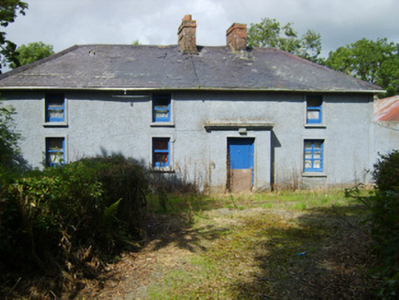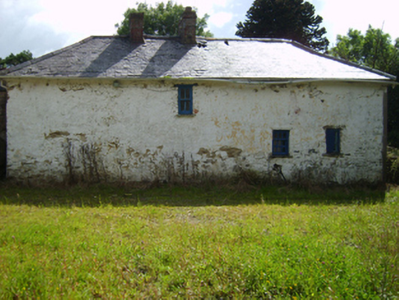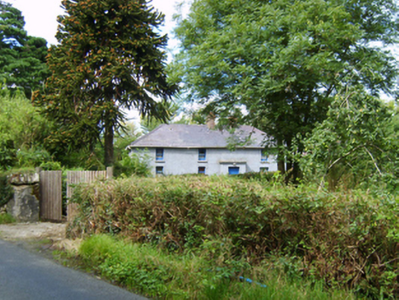Survey Data
Reg No
15701131
Rating
Regional
Categories of Special Interest
Architectural, Social
Original Use
Farm house
Date
1800 - 1839
Coordinates
313288, 153398
Date Recorded
16/08/2007
Date Updated
--/--/--
Description
Detached four-bay single-storey farmhouse with half-dormer attic, extant 1839, on a rectangular plan originally three-bay single-storey centred on single-bay single-storey flat-roofed windbreak. Extended, pre-1904, producing present composition. Now disused. Hipped slate roof on collared timber construction with clay ridge tiles, paired red brick Running bond central chimney stacks having stringcourses below capping supporting terracotta pots, and replacement uPVC rainwater goods on rendered eaves. Roughcast battered walls on rendered chamfered plinth with rendered "bas-relief" strips to corners; limewashed rendered surface finish to rear (west) elevation. Square-headed central door opening with overgrown threshold, and concealed dressings framing timber boarded door. Square-headed window openings with concrete or rendered sills, and rendered "bas-relief" surrounds framing one-over-one timber sash windows having part exposed sash boxes. Set in unkempt grounds with roughcast cylindrical piers to perimeter having rubble stone solider course coping supporting flat iron "farm gate".
Appraisal
A farmhouse identified as an integral component of the vernacular heritage of County Wexford by such attributes as the compact plan form centred on a characteristic windbreak; the construction in unrefined local materials displaying a feint battered silhouette; the somewhat disproportionate bias of solid to void in the massing compounded by the uniform or near-uniform proportions of the openings on each floor; and the high pitched roof: meanwhile, aspects of the composition clearly illustrate the continued linear development of the farmhouse in the later nineteenth century. A prolonged period of unoccupancy notwithstanding, the elementary form and massing survive intact together with substantial quantities of the original fabric, thus upholding the character or integrity of the composition. Furthermore, adjacent "tin roofed" outbuildings (extant 1904) continue to contribute positively to the group and setting values of a neat self-contained ensemble making a pleasing, if increasingly obscure visual statement in a rural street scene.





